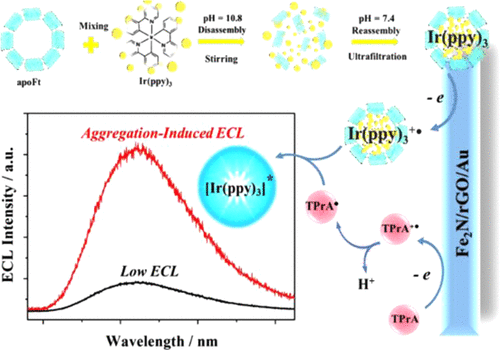当前位置:
X-MOL 学术
›
Anal. Chem.
›
论文详情
Our official English website, www.x-mol.net, welcomes your
feedback! (Note: you will need to create a separate account there.)
Aggregation-Induced Electrochemiluminescence Bioconjugates of Apoferritin-Encapsulated Iridium(III) Complexes for Biosensing Application
Analytical Chemistry ( IF 6.7 ) Pub Date : 2020-12-21 , DOI: 10.1021/acs.analchem.0c03877 Lei Yang 1 , Xu Sun 1 , Dong Wei 2 , Huangxian Ju 1 , Yu Du 1 , Hongmin Ma 1 , Qin Wei 1
Analytical Chemistry ( IF 6.7 ) Pub Date : 2020-12-21 , DOI: 10.1021/acs.analchem.0c03877 Lei Yang 1 , Xu Sun 1 , Dong Wei 2 , Huangxian Ju 1 , Yu Du 1 , Hongmin Ma 1 , Qin Wei 1
Affiliation

|
An intriguing aggregation-induced electrochemiluminescence (AIECL) bioconjugate was fabricated by encapsulating fac-tris(2-phenylpyridine)iridium(III) complexes [Ir(ppy)3] in the apoferritin (apoFt) cavity for biosensing application. Based on the unique pH-dependent disassembly/reassembly characteristic of apoFt, approximately 44.3 molecules of Ir(ppy)3 aggregated in the single cavity through both intermolecular π–π-stacking interactions and hydrogen bonds that efficiently restricted the intramolecular motions to trigger the AIECL effect. Compared to monomers, Ir(ppy)3 aggregates performed 5.3-fold-enhanced ECL emission using tri-n-propylamine (TPrA) as a coreactant. The fabricated Ir(ppy)3@apoFt bioconjugate was flexibly labeled with a detection antibody to act as a transducer for the immunosensor construction. To further catalyze the ECL reaction between the reductive TPrA• and the oxidative Ir(ppy)3+• radicals, a conductive and electroactive substrate of Fe2N and gold nanoparticle-codecorated reduced graphene oxide (Fe2N/rGO/Au) was established to incubate the capture antibody. Therefore, a “signal on” immunosensor was developed for sensitive assay of cytokeratin 19 fragment 21–1 (CYFRA 21–1), in which good linearity ranging from 1 pg/mL to 50 ng/mL with a low detection limit of 0.43 pg/mL (S/N = 3) was obtained. This study shares with an inspiration of using apoFt to design iridium(III)-based AIECL emitters, which will expand more possibilities of organic iridium(III) complexes in establishing innovative ECL immunoassays.
中文翻译:

凝聚诱导的载铁蛋白包封的铱(III)配合物的电化学发光生物共轭物,用于生物传感应用。
通过将fac -tris(2-苯基吡啶)铱(III)络合物[Ir(ppy)3 ]封装在载铁蛋白(apoFt)腔中进行生物传感应用,制备了一种引人入胜的聚集诱导的电化学发光(AIECL)生物共轭物。根据apoFt独特的pH依赖性拆解/重组特征,大约44.3分子Ir(ppy)3分子通过分子间π-π堆积相互作用和氢键聚集在单个空腔中,从而有效地限制了分子内运动来触发AIECL影响。单体相比,的Ir(ppy)3个使用三-聚集体进行5.3倍增强的ECL发射Ñ丙胺(TPRA)作为共反应物。人造Ir(ppy)3用检测抗体对apoFt生物缀合物进行灵活标记,以充当免疫传感器构建的传感器。为了进一步催化还原性TPrA •与氧化性Ir(ppy)3 +•自由基之间的ECL反应,需要使用Fe 2 N和金纳米粒子编码的氧化石墨烯(Fe 2建立N / rGO / Au以孵育捕获抗体。因此,开发了一种“信号开启”免疫传感器,用于细胞角蛋白19片段21-1(CYFRA 21-1)的灵敏测定,其线性范围从1 pg / mL到50 ng / mL,检测限为0.43 pg获得/ mL(S / N = 3)。这项研究的灵感来自于使用apoFt设计基于铱(III)的AIECL发射体,这将为建立创新的ECL免疫测定法扩展有机铱(III)复合物的更多可能性。
更新日期:2021-01-26
中文翻译:

凝聚诱导的载铁蛋白包封的铱(III)配合物的电化学发光生物共轭物,用于生物传感应用。
通过将fac -tris(2-苯基吡啶)铱(III)络合物[Ir(ppy)3 ]封装在载铁蛋白(apoFt)腔中进行生物传感应用,制备了一种引人入胜的聚集诱导的电化学发光(AIECL)生物共轭物。根据apoFt独特的pH依赖性拆解/重组特征,大约44.3分子Ir(ppy)3分子通过分子间π-π堆积相互作用和氢键聚集在单个空腔中,从而有效地限制了分子内运动来触发AIECL影响。单体相比,的Ir(ppy)3个使用三-聚集体进行5.3倍增强的ECL发射Ñ丙胺(TPRA)作为共反应物。人造Ir(ppy)3用检测抗体对apoFt生物缀合物进行灵活标记,以充当免疫传感器构建的传感器。为了进一步催化还原性TPrA •与氧化性Ir(ppy)3 +•自由基之间的ECL反应,需要使用Fe 2 N和金纳米粒子编码的氧化石墨烯(Fe 2建立N / rGO / Au以孵育捕获抗体。因此,开发了一种“信号开启”免疫传感器,用于细胞角蛋白19片段21-1(CYFRA 21-1)的灵敏测定,其线性范围从1 pg / mL到50 ng / mL,检测限为0.43 pg获得/ mL(S / N = 3)。这项研究的灵感来自于使用apoFt设计基于铱(III)的AIECL发射体,这将为建立创新的ECL免疫测定法扩展有机铱(III)复合物的更多可能性。











































 京公网安备 11010802027423号
京公网安备 11010802027423号